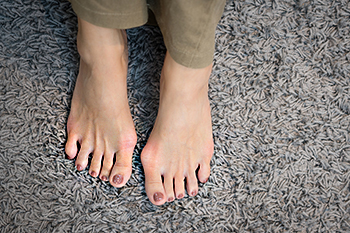Easily Noticed Bunions
Tuesday, 02 May 2023 00:00
There is no mistaking a bunion. It is easily noticed by the hard bump that forms on the side of the big toe. It is considered to be a deformity and can happen from wearing shoes that do not have adequate room in the toe area. It may also occur for genetic reasons or as a result of an abnormal foot structure. If the bunion is severe, it may force the other toes to shift away from the big toe and toward each other, possibly causing the need for wider shoes to be purchased. Corns and calluses may form on top of the toes where they meet the shoe, and there may be a reduced range of motion in the big toe. Mild relief may be found when a protective pad is worn over the bunion and larger shoes are worn. Some patients will have their podiatrist tape their foot into a normal position, and this may be helpful in eliminating any existing pressure. Surgery may be considered for permanent removal, and this type of treatment may be chosen if the bunion interferes with completing daily activities. If you have developed a bunion, it is suggested that you consult with a podiatrist who can help you with the treatment option that is best for you.
If you are suffering from bunion pain, contact one of our doctors of Coral Desert Foot & Ankle. Our doctors can provide the care you need to keep you pain-free and on your feet.
What Is a Bunion?
Bunions are painful bony bumps that usually develop on the inside of the foot at the joint of the big toe. As the deformity increases over time, it may become painful to walk and wear shoes. Women are more likely to exacerbate existing bunions since they often wear tight, narrow shoes that shift their toes together. Bunion pain can be relieved by wearing wider shoes with enough room for the toes.
Causes
- Genetics – some people inherit feet that are more prone to bunion development
- Inflammatory Conditions - rheumatoid arthritis and polio may cause bunion development
Symptoms
- Redness and inflammation
- Pain and tenderness
- Callus or corns on the bump
- Restricted motion in the big toe
In order to diagnose your bunion, your podiatrist may ask about your medical history, symptoms, and general health. Your doctor might also order an x-ray to take a closer look at your feet. Nonsurgical treatment options include orthotics, padding, icing, changes in footwear, and medication. If nonsurgical treatments don’t alleviate your bunion pain, surgery may be necessary.
If you have any questions, please feel free to contact one of our offices located in St. George and Kanab, UT, and Mesquite, NV . We offer the newest diagnostic and treatment technologies for all your foot care needs.




